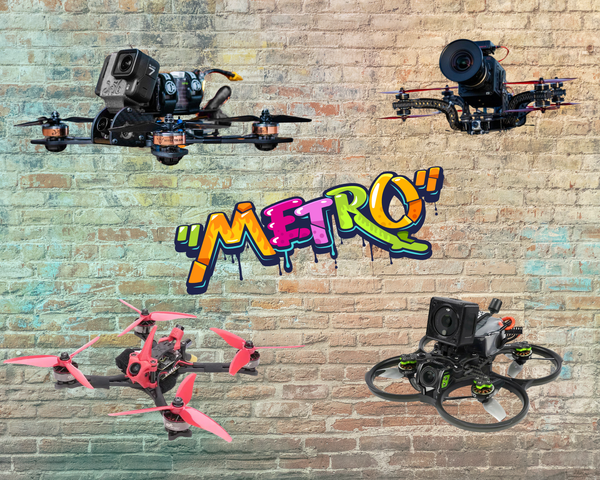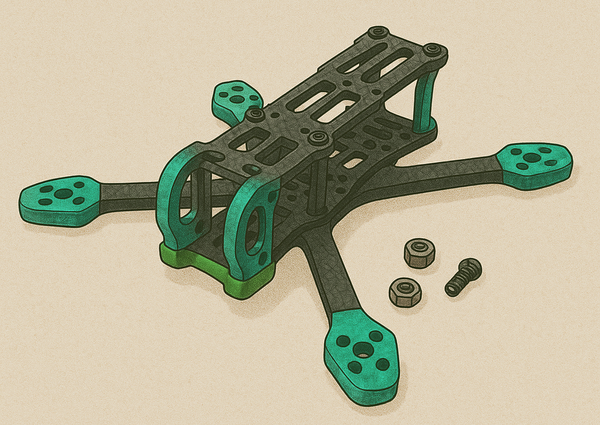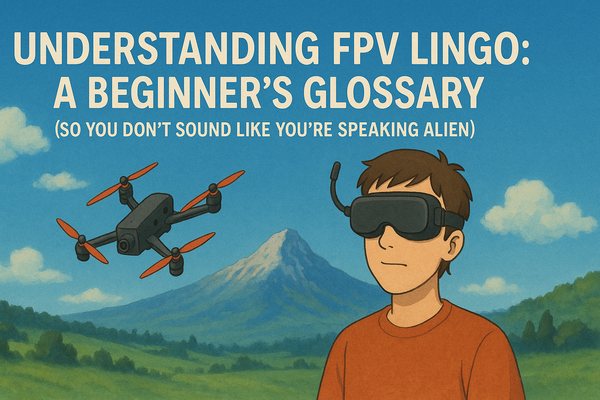A Deep Dive into FPV Frame Materials, 3D Prints, and Taming Vibrations


We've explored the shapes and sizes of FPV frames, but what about what they're made of and how they come to be? And how can the magic of 3D printing and understanding vibrations elevate your FPV experience? Let's get into the nitty-gritty!
The Backbone: Materials and Manufacturing
The vast majority of high-performance FPV drone frames are crafted from carbon fiber. This composite material is prized for its exceptional strength-to-weight ratio. It's significantly lighter than aluminum or steel while being remarkably stiff and strong, making it ideal for withstanding the stresses of flight and those inevitable crashes.
How Carbon Fiber Frames Are Made:
The process typically involves layering sheets of carbon fiber fabric, which are then impregnated with a resin (like epoxy). These layers are carefully aligned with the desired grain direction to maximize strength in specific areas. The layup (the sequence and orientation of the carbon fiber layers) is a critical factor in the frame's overall strength and flexibility.
Once the layers are stacked, they are placed in a mold that defines the shape of the frame component (like an arm or a top plate). This mold is then subjected to heat and pressure in a process called curing. The heat hardens the resin, bonding the carbon fiber layers together into a solid, strong piece.
Different grades and weaves of carbon fiber exist. For example, 3K carbon fiber has a distinct woven pattern, while unidirectional carbon fiber has fibers aligned in a single direction for maximum strength along that axis. The quality of the carbon fiber and the curing process significantly impact the frame's durability and performance.
Beyond Carbon Fiber:
While carbon fiber dominates the high-performance FPV scene, you might encounter frames made from other materials, especially in the micro and toy drone categories. These can include:
- Plastic/Polymer: More flexible and often found in smaller, less expensive drones. They offer good impact resistance at a lower cost but may not be as stiff or durable as carbon fiber for larger, more powerful setups.
- Aluminum: Strong and relatively lightweight, but can bend or deform more easily in crashes compared to carbon fiber. Often used for specific structural elements or camera mounts.
The Power of 3D Printing in FPV
3D printing has revolutionized many aspects of the FPV hobby, and frames are no exception.
Expandability and Customization:
One of the biggest advantages of 3D printing is the ability to create custom parts and accessories for your frame. This opens up a world of expandability:
- Camera Mounts: You can design and print specific mounts for your FPV camera, HD action camera (like a GoPro or DJI Osmo Action), or even specialized cameras for different purposes. This allows for optimal viewing angles and secure attachment.
- Antenna Mounts: 3D-printed mounts can securely hold your receiver and video transmitter antennas in optimal orientations for the best signal reception and transmission, protecting them from damage.
- Gopro Session/Naked GoPro Cases: Lightweight and aerodynamic cases can be 3D-printed to house stripped-down GoPros for FPV filming, saving weight and improving performance.
- Arm Protectors/Skids: These printed parts can add an extra layer of protection to the ends of your frame arms, helping to absorb impact during crashes and prevent damage to the carbon fiber.
- Wire Management Solutions: Custom clips and guides can be printed to keep your wiring neat and tidy, reducing the risk of snagging and improving airflow.
- Battery Mounts/Pads: 3D-printed solutions can offer secure and vibration-dampening mounts for your LiPo batteries.
3D Printing Materials:
A variety of materials are used for 3D-printed FPV parts, each with its own properties:
- TPU (Thermoplastic Polyurethane): This flexible and durable material is excellent for parts that need to absorb impact or resist bending, such as camera mounts, antenna mounts, and arm protectors.
- PETG (Polyethylene Terephthalate Glycol-modified): A strong and relatively easy-to-print material with good impact resistance and temperature tolerance. Often used for more structural parts or mounts.
- ABS (Acrylonitrile Butadiene Styrene): A strong and rigid plastic, but can be more challenging to print due to warping.
- Nylon: A very strong and wear-resistant material, often used for more demanding applications but can be more difficult to print.
Open Source vs. Closed Source Frames and 3D Prints:
The FPV community embraces open-source in many areas, and frame design is no exception.
- Open Source Frames: Some frame designers release their CAD (Computer-Aided Design) files publicly under open-source licenses. This allows anyone to download the files, modify the design, and even 3D print parts or entire frames (if they have access to a 3D printer capable of printing durable materials). This fosters innovation and allows users to customize their setups extensively. The availability of 3D-printable accessories and replacement parts is often much greater for open-source frames due to community contributions.
- Closed Source Frames: Many commercial frame manufacturers keep their designs proprietary. While you can still purchase replacement parts from them, the availability of community-designed 3D-printed accessories might be more limited. You are typically restricted to the official ecosystem for modifications and repairs.
The Enemy Within: Resonance and Vibrations
Vibrations are the bane of smooth FPV flight and clean video. They can be caused by various factors, including motor imbalances, bent propellers, and even the frame itself resonating at certain frequencies.
Resonance:
Resonance occurs when an object (like a part of your frame) is subjected to vibrations at its natural frequency. This can cause the vibrations to amplify significantly, leading to issues like "jello" in your video footage (wobbly distortions) and even premature component failure due to excessive stress. Frame design and material choice play a role in how susceptible a frame is to resonance. Stiffer and well-damped materials like carbon fiber are generally better at minimizing resonance.
Mitigating Vibrations:
Several techniques are used to combat vibrations in FPV drones:
- Prop Balancing: Ensuring your propellers are perfectly balanced is crucial. Even slight imbalances can introduce significant vibrations.
- Motor Soft Mounting: Using rubber or TPU grommets between the motors and the frame arms helps to isolate motor vibrations from the rest of the drone.
- Flight Controller Soft Mounting: Similarly, mounting the flight controller on soft, vibration-dampening standoffs helps to isolate it from frame vibrations, leading to cleaner sensor readings and better flight performance.
- Prop Filters in Software: Flight controller firmware like Betaflight has software filters that can help to attenuate high-frequency vibrations in the gyro and accelerometer data. However, it's always better to address the mechanical sources of vibration first.
- Frame Design: Well-designed frames often incorporate features to reduce resonance, such as stiff arms and strategically placed bracing.
Understanding the materials your frame is made of, the potential for 3D-printed enhancements, and the importance of minimizing vibrations are all key aspects of building and maintaining a high-performing FPV drone. As you progress in the hobby, you'll likely experiment with different materials and 3D-printed parts to optimize your setup for your specific flying style and needs.




